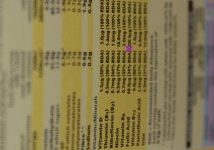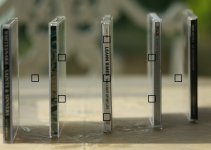-
Welcome to BirdForum, the internet's largest birding community with thousands of members from all over the world. The forums are dedicated to wild birds, birding, binoculars and equipment and all that goes with it.
Please register for an account to take part in the discussions in the forum, post your pictures in the gallery and more.
You are using an out of date browser. It may not display this or other websites correctly.
You should upgrade or use an alternative browser.
You should upgrade or use an alternative browser.
Front focusing, what is it. (1 Viewer)
- Thread starter Saphire
- Start date
More options
Who Replied?Front focusing simply means that the camera focuses (slightly) closer than it should be... if you're using a shallow DOF it can become very obvious. In the attached shot the X marks the point I was focusing on, as you can see the sharpest area is a bit in front of this...
Attachments
Thanks postcard, thats easy to understand I don't think I had better test mine just in case I find it out, I have had my camera a couple of months now and would be lost if there was a problem and had to send it back.
you'd have noticed if it was happening... The first batch of photos that I took with the camera had a clear problem, so I did the above test to prove that it was front focusing. If you shoot with a lens wide open giving a shallow DOF then front focusing is obvious in most photos.
tdodd
Just call me Tim
With respect, the example by postcardcv does illustrate front focusing, in that there is a bias towards sharpness in front of the intended focus point, but if that was set up as an actual test of the camera/lens I do not believe it is valid. Here's why....
The focus sensor in the camera is quite a bit larger than the indicated focus point in the viewfinder, probably about 3 times larger than suggested, both horizontally and vertically. In other words, 9 times the area, maybe a bit more. I also believe that focus mechanisms have a preference to hit focus on the closest part of the subject. When you have an angled subject like that sheet of paper the autofocus sensor is not only concentrating on the exact text within the focus square but sees the stuff around the square, which in this example will include parts of the subject both in front of and behind the intended point of focus. In other words, this sort of tests proves little, except that the focus is approximately right.
In my opinion, based on much that I have read on the subject, your focus target should be square on to the camera and not angled. You should then place objects at either side of the intended subject, both closer to the camera and further away than the subject, but with good separation between the focus target and the next object on either side. You focus on the subject and then see how your depth of field covers the objects nearer and farther away. The intended focus should be pin sharp, with progressively increasing softness as you view the objects farther from and closer to the subject.
Here is a quick test I set up to show what I mean. The camera is elevated a little, to make the differing distances more obvious. Strictly speaking the camera should have been level with the CDs to make it as accurate as possible but the test works well enough. You need the lens wide open to minimise DOF and thus emphasise any focus inaccuracies. The camera should be on a tripod, with remote or timer release, or even mirror lock up and IS turned off. You need good lighting to generate adequate contrast, to allow the AF to perform well, and to judge the results properly. Ideally you should repeat the test a few times, manually defocusing the lens each time, both too close and too distant, just to make sure that the camera/lens will reliably bring you back to the right focus point each time.
As long as you keep separation between the focus target and the next object in the frame on each side you could actually have 20 CDs or so at either side - they can be as close to each other as you like. But they must be kept apart from the main subject in order that focus doesn't get drawn to the wrong subject due to the large AF sensor size.
I focused here on the All Saints CD in the middle. I've also included a crop at 50% reduction - 100% wouldn't really fit enough of the frame into 800* XXX pixels to see much
The focus sensor in the camera is quite a bit larger than the indicated focus point in the viewfinder, probably about 3 times larger than suggested, both horizontally and vertically. In other words, 9 times the area, maybe a bit more. I also believe that focus mechanisms have a preference to hit focus on the closest part of the subject. When you have an angled subject like that sheet of paper the autofocus sensor is not only concentrating on the exact text within the focus square but sees the stuff around the square, which in this example will include parts of the subject both in front of and behind the intended point of focus. In other words, this sort of tests proves little, except that the focus is approximately right.
In my opinion, based on much that I have read on the subject, your focus target should be square on to the camera and not angled. You should then place objects at either side of the intended subject, both closer to the camera and further away than the subject, but with good separation between the focus target and the next object on either side. You focus on the subject and then see how your depth of field covers the objects nearer and farther away. The intended focus should be pin sharp, with progressively increasing softness as you view the objects farther from and closer to the subject.
Here is a quick test I set up to show what I mean. The camera is elevated a little, to make the differing distances more obvious. Strictly speaking the camera should have been level with the CDs to make it as accurate as possible but the test works well enough. You need the lens wide open to minimise DOF and thus emphasise any focus inaccuracies. The camera should be on a tripod, with remote or timer release, or even mirror lock up and IS turned off. You need good lighting to generate adequate contrast, to allow the AF to perform well, and to judge the results properly. Ideally you should repeat the test a few times, manually defocusing the lens each time, both too close and too distant, just to make sure that the camera/lens will reliably bring you back to the right focus point each time.
As long as you keep separation between the focus target and the next object in the frame on each side you could actually have 20 CDs or so at either side - they can be as close to each other as you like. But they must be kept apart from the main subject in order that focus doesn't get drawn to the wrong subject due to the large AF sensor size.
I focused here on the All Saints CD in the middle. I've also included a crop at 50% reduction - 100% wouldn't really fit enough of the frame into 800* XXX pixels to see much
Last edited:
tdodd
Just call me Tim
Here's another effort, this time to give a finer indication of exactly where the DOF lies. As you see, I've kept the separation between the focus subject and the rest of the objects in the frame, but by placing the rest of the CDs close together and having a finer angle of distance change I can better see if I'm perhaps a little bit front focused, back focused or spot on. The first CD on either side of the focus subject is at the same distance as the subject and then they get progressively closer on the left and farther away on the right. Once again, this is a full frame and a 50% crop.
Last edited:
Saphire
Christine
Keith Reeder
Watch the birdie...
Two ways, Mav - either by opening the image up in Zoombrowser EX that comes with Canon cameras, or by using Breezebrowser, a Third Party RAW converter.
With respect, the example by postcardcv does illustrate front focusing, in that there is a bias towards sharpness in front of the intended focus point, but if that was set up as an actual test of the camera/lens I do not believe it is valid. Here's why....
That's a fair point and I can see why your method of testing this is more effective, I only did any sort of test as I was aware from real shots that I had a problem. I used your method to evaluate the replacement camera and it all seemed fine, real world test today has confirmed this.
Similar threads
Users who are viewing this thread
Total: 2 (members: 0, guests: 2)







